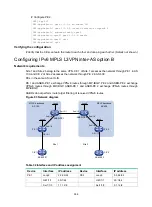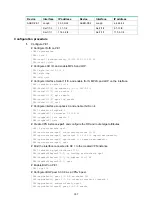
352
Table 31 Interface and IP address assignment
Device
Interface
IP address
Device
Interface
IP address
CE 1
GE1/1/1
2001:1::1/96
CE 2
GE1/1/1
2001:2::1/96
PE 1
Loop0
1.1.1.9/32
PE 2
Loop0
4.4.4.9/32
GE1/1/1
2001:1::2/96
GE1/1/1
2001:2::2/96
POS1/1/0
172.1.1.2/24
POS1/1/0
162.1.1.2/24
ASBR-PE1 Loop0 2.2.2.9/32 ASBR-PE2
Loop0 3.3.3.9/32
POS1/1/0
172.1.1.1/24
POS1/1/0
162.1.1.1/24
POS1/1/1
2002:1::1/96
POS1/1/1
2002:1::2/96
Configuration procedure
1.
Configure an IGP on each MPLS backbone to ensure IP connectivity within the backbone.
This example uses OSPF. Be sure to advertise the route to the 32-bit loopback interface
address of each router through OSPF. Use the loopback interface address of a router as the
router's LSR ID. (Details not shown.)
# Execute the
display ospf peer
command to verify that each ASBR-PE has established an
OSPF adjacency in Full state with the PE in the same AS, and that the PEs and ASBR-PEs in
the same AS have learned the routes to the loopback interfaces of each other. Execute the
ping
command to verify that the PEs and ASBR-PEs in the same AS can ping each other.
(Details not shown.)
2.
Configure basic MPLS and enable MPLS LDP on each MPLS backbone to establish LDP LSPs:
# Configure basic MPLS on PE 1, and enable MPLS LDP for both PE 1 and the interface
connected to ASBR-PE 1.
<PE1> system-view
[PE1] mpls lsr-id 1.1.1.9
[PE1] mpls ldp
[PE1-ldp] quit
[PE1] interface pos 1/1/0
[PE1-Pos1/1/0] mpls enable
[PE1-Pos1/1/0] mpls ldp enable
[PE1-Pos1/1/0] quit
# Configure basic MPLS on ASBR-PE 1, and enable MPLS LDP for both ASBR-PE 1 and the
interface connected to PE 1.
<ASBR-PE1> system-view
[ASBR-PE1] mpls lsr-id 2.2.2.9
[ASBR-PE1] mpls ldp
[ASBR-PE1-ldp] quit
[ASBR-PE1] interface pos 1/1/0
[ASBR-PE1-Pos1/1/0] mpls enable
[ASBR-PE1-Pos1/1/0] mpls ldp enable
[ASBR-PE1-Pos1/1/0] quit
# Configure basic MPLS on ASBR-PE 2, and enable MPLS LDP for both ASBR-PE 2 and the
interface connected to PE 2.
<ASBR-PE2> system-view
[ASBR-PE2] mpls lsr-id 3.3.3.9
[ASBR-PE2] mpls ldp
[ASBR-PE2-ldp] quit
















































